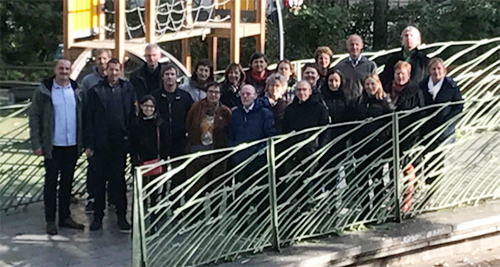
12th Meeting of the Panel on Diagnostics in Nematology
EPPO Headquarters, Paris (FR) 2019-11-12/14

Development of EPPO diagnostic protocols
The Panel reviewed one new protocol and several protocols for which revision is in progress (see below). They also made plans for a new protocol on Meloidogyne graminicola.
-
PM 7/NEW (first draft available) Longidorus diadecturus
A draft of this new protocol was reviewed by the Panel. Some changes (such as addition of extra figures) and additional tasks (summarizing the most important features of the species, investigation of sequences available) were agreed upon. It is planned that this protocol will be sent for country consultation in early 2020.
-
PM 7/NEW (first draft available) Guidelines on the maintenance of nematode collections for the production of reference material
A preliminary document was prepared by the EPPO Secretariat compiling information gathered from the workshop on the maintenance of nematode collection (2017). This information included Standard Operating Procedures (SOPs) received after the workshop and outcomes from different projects (Q-Collect project, Euphresco project ‘Cyst and Melo Collect’). The Panel reviewed the document and agreed on the content of the document. A small expert working group (EWG) was created to continue the work on this document.
-
PM 7/040 Globodera rostochiensis and G. pallida
A revision of this Standard was presented. A new real-time PCR test has been added. It is planned that this revised protocol will be sent for country consultation in early 2020 when the table ‘Morphological and morphometric characters useful for identification of Globodera species’ is finalized.
- PM 7/94 Hirschmanniella spp.
This protocol was updated to include new species which have been described. Some further changes are required as the new EU regulation which entered into force on the 14th of December (Commission Implementing Regulation (EU) 2019/2072) will exclude Five Hirschmanniella spp. (H. behningi, H. gracilis, H. halophila, H. loofi and H. zostericola). Descriptions of all 5 species are now required and all the molecular tests need to be checked to see which species are targeted. Once this is done the protocol will be sent for country consultation.
-
PM 7/004 Bursaphelenchus xylophilus
A revision of this Standard is underway to add information on extraction from insect vectors and a LAMP test (also included in the IPPC protocol on this pest). It is planned that this revised protocol will be sent for country consultation in the first half of 2020. Information from Test Performance Studies performed in the framework of the EU funded Project VALITEST ![]() will be included in the Standard.
will be included in the Standard.
Since the last meeting protocols the following protocols have been approved and published:
- PM 7/089 (revision) Heterodera glycines
- PM 7/136 (new) Meloidogyne mali
Risk management measures for Meloidogyne species
The Panel discussed the generic conditions that would be required for establishing pest-free areas (PFA), pest free places of production (PFPP) and pest free production sites (PFPS) for Meloidogyne species. The Panel concluded that measures in PM 9/17 for M. chitwoodi and M. fallax can serve as a basis to develop measures for other Meloidogyne species. The Panel concluded that establishing a PFA for a particular Meloidogyne species was not realistic because of the different pathways for entry and spread, except for Meloidogyne species with a more limited host range. Finally, the measures proposed by the Panel to establish PFPP and PFPS are similar to the ones listed in PM 5/8. The outcome of the discussion will be presented and discussed during the next Panel on Phytosanitary Measures.
Other topics
The Pictorial Glossary ![]() will be enriched with the new terms used in the diagnostic protocol of Longidorus diadecturus. A list of Euphresco
will be enriched with the new terms used in the diagnostic protocol of Longidorus diadecturus. A list of Euphresco ![]() projects was presented to the Panel. The ongoing Euphresco Project ‘Global warming and distribution of root-knot nematode (RKN) species of the tropical group (MeloTrop)’ was presented.
projects was presented to the Panel. The ongoing Euphresco Project ‘Global warming and distribution of root-knot nematode (RKN) species of the tropical group (MeloTrop)’ was presented.
The VALITEST ![]() project, information on the Database on Diagnostic Expertise
project, information on the Database on Diagnostic Expertise ![]() and information on EPPO-Q-bank
and information on EPPO-Q-bank ![]() was presented to the Panel
was presented to the Panel
The Panel exchanged information on emerging pests and the situation in their countries. This included presentations on:
- Nematodes associated with new tuber crops,
- Activities at the Central Institute for Supervising and Testing in Agriculture (CZ), information on new virulent populations of potato cyst nematodes (PCN) detected in the Netherlands,
- The situation concerning Meloidogyne fallax in the United Kingdom,
- Information on Aphelenchoides besseyi in Romania on rice seeds,
- Damage associated with nematodes on Taxus media cv. Hillii in Norway,
- The situation of Heterodera glycines in Italy.
A presentation was given on the scope and objectives of the European Union Reference Laboratory (EURL) for plant pests nematodes and activities planned in the next year.
Next Panel meeting
It will be investigated if it is possible to hold the next meeting in Croatia in early February 2021.
